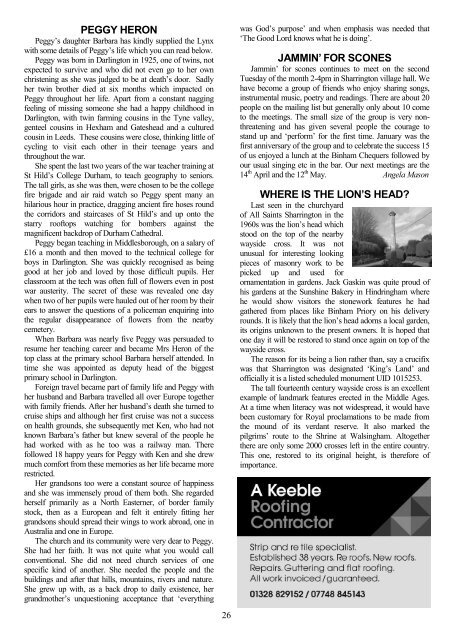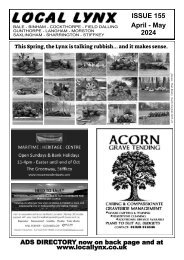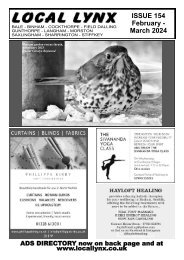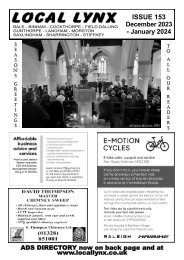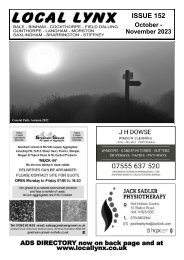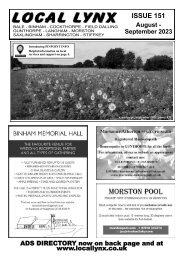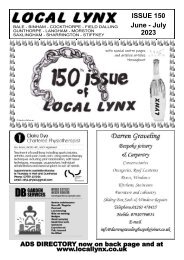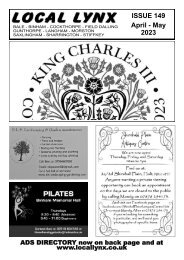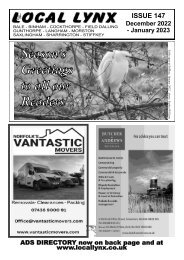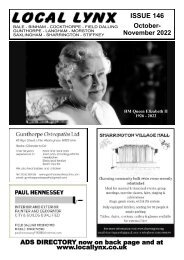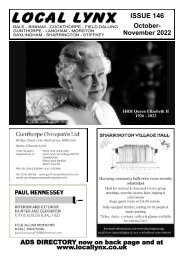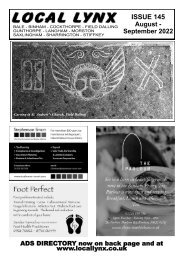Local Lynx No.131 - April/May 2020
The community newspaper for 10 North Norfolk villages
The community newspaper for 10 North Norfolk villages
Create successful ePaper yourself
Turn your PDF publications into a flip-book with our unique Google optimized e-Paper software.
PEGGY HERON<br />
Peggy‟s daughter Barbara has kindly supplied the <strong>Lynx</strong><br />
with some details of Peggy‟s life which you can read below.<br />
Peggy was born in Darlington in 1925, one of twins, not<br />
expected to survive and who did not even go to her own<br />
christening as she was judged to be at death‟s door. Sadly<br />
her twin brother died at six months which impacted on<br />
Peggy throughout her life. Apart from a constant nagging<br />
feeling of missing someone she had a happy childhood in<br />
Darlington, with twin farming cousins in the Tyne valley,<br />
genteel cousins in Hexham and Gateshead and a cultured<br />
cousin in Leeds. These cousins were close, thinking little of<br />
cycling to visit each other in their teenage years and<br />
throughout the war.<br />
She spent the last two years of the war teacher training at<br />
St Hild‟s College Durham, to teach geography to seniors.<br />
The tall girls, as she was then, were chosen to be the college<br />
fire brigade and air raid watch so Peggy spent many an<br />
hilarious hour in practice, dragging ancient fire hoses round<br />
the corridors and staircases of St Hild‟s and up onto the<br />
starry rooftops watching for bombers against the<br />
magnificent backdrop of Durham Cathedral.<br />
Peggy began teaching in Middlesborough, on a salary of<br />
£16 a month and then moved to the technical college for<br />
boys in Darlington. She was quickly recognised as being<br />
good at her job and loved by those difficult pupils. Her<br />
classroom at the tech was often full of flowers even in post<br />
war austerity. The secret of these was revealed one day<br />
when two of her pupils were hauled out of her room by their<br />
ears to answer the questions of a policeman enquiring into<br />
the regular disappearance of flowers from the nearby<br />
cemetery.<br />
When Barbara was nearly five Peggy was persuaded to<br />
resume her teaching career and became Mrs Heron of the<br />
top class at the primary school Barbara herself attended. In<br />
time she was appointed as deputy head of the biggest<br />
primary school in Darlington.<br />
Foreign travel became part of family life and Peggy with<br />
her husband and Barbara travelled all over Europe together<br />
with family friends. After her husband‟s death she turned to<br />
cruise ships and although her first cruise was not a success<br />
on health grounds, she subsequently met Ken, who had not<br />
known Barbara‟s father but knew several of the people he<br />
had worked with as he too was a railway man. There<br />
followed 18 happy years for Peggy with Ken and she drew<br />
much comfort from these memories as her life became more<br />
restricted.<br />
Her grandsons too were a constant source of happiness<br />
and she was immensely proud of them both. She regarded<br />
herself primarily as a North Easterner, of border family<br />
stock, then as a European and felt it entirely fitting her<br />
grandsons should spread their wings to work abroad, one in<br />
Australia and one in Europe.<br />
The church and its community were very dear to Peggy.<br />
She had her faith. It was not quite what you would call<br />
conventional. She did not need church services of one<br />
specific kind of another. She needed the people and the<br />
buildings and after that hills, mountains, rivers and nature.<br />
She grew up with, as a back drop to daily existence, her<br />
grandmother‟s unquestioning acceptance that „everything<br />
was God‟s purpose‟ and when emphasis was needed that<br />
„The Good Lord knows what he is doing‟.<br />
JAMMIN’ FOR SCONES<br />
Jammin‟ for scones continues to meet on the second<br />
Tuesday of the month 2-4pm in Sharrington village hall. We<br />
have become a group of friends who enjoy sharing songs,<br />
instrumental music, poetry and readings. There are about 20<br />
people on the mailing list but generally only about 10 come<br />
to the meetings. The small size of the group is very nonthreatening<br />
and has given several people the courage to<br />
stand up and „perform‟ for the first time. January was the<br />
first anniversary of the group and to celebrate the success 15<br />
of us enjoyed a lunch at the Binham Chequers followed by<br />
our usual singing etc in the bar. Our next meetings are the<br />
14 th <strong>April</strong> and the 12 th <strong>May</strong>. Angela Mason<br />
WHERE IS THE LION’S HEAD?<br />
Last seen in the churchyard<br />
of All Saints Sharrington in the<br />
1960s was the lion‟s head which<br />
stood on the top of the nearby<br />
wayside cross. It was not<br />
unusual for interesting looking<br />
pieces of masonry work to be<br />
picked up and used for<br />
ornamentation in gardens. Jack Gaskin was quite proud of<br />
his gardens at the Sunshine Bakery in Hindringham where<br />
he would show visitors the stonework features he had<br />
gathered from places like Binham Priory on his delivery<br />
rounds. It is likely that the lion‟s head adorns a local garden,<br />
its origins unknown to the present owners. It is hoped that<br />
one day it will be restored to stand once again on top of the<br />
wayside cross.<br />
The reason for its being a lion rather than, say a crucifix<br />
was that Sharrington was designated „King‟s Land‟ and<br />
officially it is a listed scheduled monument UID 1015253.<br />
The tall fourteenth century wayside cross is an excellent<br />
example of landmark features erected in the Middle Ages.<br />
At a time when literacy was not widespread, it would have<br />
been customary for Royal proclamations to be made from<br />
the mound of its verdant reserve. It also marked the<br />
pilgrims‟ route to the Shrine at Walsingham. Altogether<br />
there are only some 2000 crosses left in the entire country.<br />
This one, restored to its original height, is therefore of<br />
importance.<br />
26


